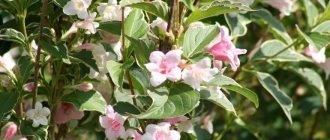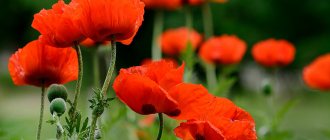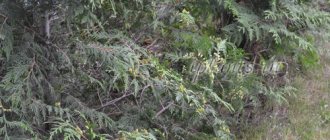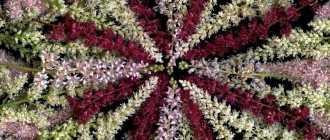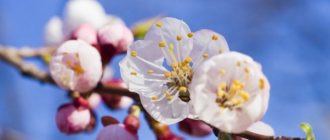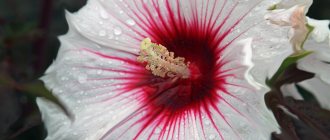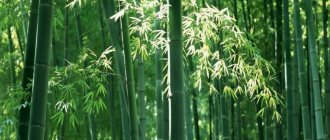Mahonia is a close relative of barberry, inferior to it in popularity, but quite capable of competing both in decorative appearance and in the taste and usefulness of its fruits. This evergreen shrub is undeservedly little cultivated in Russia due to its insufficient popularization. Meanwhile, it produces edible, tasty berries, and growing mahonia does not cause unnecessary garden troubles. Oregon mountain grapes are so called for the appearance of the fruits, which resemble bunches of grapes.
Mahonia - photo and description of the bush
In the wild, mahonia can take the form of not only a shrub, but also a full-fledged tree, however, in garden plots it is usually a bush no more than a meter high. Classified as a member of the Barberry family. Unlike barberry, mahonia shoots are not lined with thorns. The stems have a gray-pink color, atypical for garden shrubs, which becomes dark gray over the years. The root system lies superficially and actively grows in breadth, due to which it produces active root shoots. If this is not dealt with, the plant will spontaneously form dense thickets. The leaf blades have a dark, rich green, shiny front side and a matte underside of a lighter color, paired with red-brown petioles. With the onset of the first cold days of autumn, the foliage changes its color to purple-red, which looks impressive against the backdrop of dark clusters of ripe berries.
Description of the plant
Although North America is considered to be the birthplace of mahonia, representatives of the species can be found in the southern regions of Russia and eastern Asia.
It got its name thanks to the work of the Irish-American gardener Bernard McMahon, who helped adapt the broad-leaved, low-growing bushes for further cultivation in the United States, and also published a complete book of gardening. A close relative of barberry grows everywhere from Colombia to California, in the northern Caucasus, the Baltic states and Ukraine.
The popular Mahonia aquifolium is not sensitive to low temperatures. It freezes only in severe frost conditions with poor coverage of the root part.
Oregon grapes enjoy nutritious, fresh soil but can tolerate soil compaction in dry areas. In its natural habitat, it prefers mountain slopes, forest thickets, moist soil and the shady side of areas.
Young leaves are leathery and have a reddish tint. In summer they turn dark green with a glossy surface. By late autumn, when access to sunlight is limited, they turn bronze and dark brown. The flowering period coincides with the last days of April and the beginning of May. Accompanied by the appearance of edible bluish-black berries, the size of which does not exceed 8 mm. A bluish coating forms on ripe fruits in September.
Flowering and fruiting
In order for Mahonia to bear fruit, cross-pollination of a pair of shrubs is required - a male and a female. The first buds appear in April, and very quickly the bush is covered with panicle inflorescences that are vaguely similar in appearance to mimosa. Flowering lasts about 2 weeks, full ripening of the berries continues until the end of summer. They hang on the branches for a long time and do not fall off. You can leave them on until winter, and they will still be just as tasty and healthy.
Mahonia fruiting begins at 3 years of age.
Varieties most popular among gardeners
Rose Pomponella - characteristics of the varietal shrub
The varieties presented below are winter-hardy and unpretentious in care, which attracts the attention of gardeners.
- Mahonia Apollo. The bush grows from 50 to 100 cm. The leaves are 25 cm long, have a sharp-toothed edge and consist of 7 leaf plates. In summer they are green, and in autumn they turn brown. The flowers are lemon-colored. Dark blue berries contain a waxy coating on the skin.
- Mahonia atropurpurea (Autropurpurea). The height of the bush reaches 65 cm. The leaves are dark green. They do not exceed 30 cm in length. The flowers are bright yellow.
- Mahonia Smaragd. A distinctive feature is shiny emerald-colored leaves with a clear pattern of veins.
Description and photos of Mahonia varieties
The genus includes about fifty species. Of these, only three are suitable for planting in open ground in regions with a continental climate - creeping (low-growing variety), Japanese and holly. The last type is the most common, decorative and adapted for growing in Russian gardens and parks. The best and most popular varieties are:
- "Apollo". The variety was bred by Dutch breeders. It is distinguished by its slow growth, neat crown and bright appearance. Its shape, unlike other varietal varieties of mahonia holly, does not need to be carefully monitored, scrupulously pruning the shoots so that they do not turn the bush into a shapeless pile of branches. Blooms brightly and abundantly.
- "Emerald". Also bred in Holland, but not so long ago, therefore less known. The crown is more spreading and needs shaping. It is especially decorative during flowering; it blooms and bears fruit profusely. Grows up to 70 cm, tolerates frosts down to -27C without shelter.
- "Orange Frame". Throughout the summer, the foliage is brick-orange, changing color to red with the onset of cold weather.
- "Gracilis". A distinctive feature of the variety is the more elongated shape of the leaves, giving the bush a very graceful outline.
- "Aurea". Another varietal variety with a bright golden-orange crown.
- "Jaglandifolia". It stands out from others with its original shape of leaf blades, reminiscent of a walnut leaf.
Mahonia is a real find for breeders, since it easily crosses not only between its own species, but also with other representatives of the Barberry family. The reason lies in their insignificant differences, which, by and large, concern only the spikes - whether they are present or absent. The most famous and noteworthy garden hybrids.
- "Newberg Megabarberry." This is a classic hybrid obtained by crossing two basic varieties of its genus - mahonia holly and common barberry. It has excellent winter hardiness, blooms very beautifully in a bright yellow palette, and exudes a strong pleasant aroma during flowering. Can reach a meter in height.
- "Winter sun". An interesting result of crossing the Japanese variety that grows in our country with the less common Mahonia lomarielifolia. This variety blooms in winter, which is its most spectacular feature and the main difficulty of growing and caring for in cold climates. In the southern regions it grows taller than human height.
Use in the garden
Thanks to its evergreen shining leaves, mahonia is a decoration of the garden even in winter. It is used for:
- planting in the center of the lawn;
- for group plantings;
- for unformed hedges;
- as a soil cover;
- as a medicinal plant for skin diseases;
- as a dye;
- Edible fruits without seeds are used in jelly, compotes, and wine.
Most often, the shrub is planted in the form of low hedges - it fulfills this role perfectly.
Photo. Mahonia holly in landscape design
Mahonia has many uses in the garden. Looks good in single-species groups and also goes well with other plants:
- yew;
- barberry;
- hosts.
Mahonia was used by North American Indians for gastrointestinal infections, wounds, and skin diseases. Research is currently being conducted on the use of the plant in the treatment of psoriasis.
Attention! Mahonia is related to barberry. Like barberry, it contains berberine. That is why mahogany fruits, although edible, cannot be eaten by pregnant women.
The fruits are sour. They are used for alcohol tinctures, less often as an additive to muesli.
Mahonia is a versatile and beautiful garden shrub, decorative all year round:
- in spring it decorates the garden with beautiful yellow flowers;
- in summer - blue-blue fruits;
- in autumn - red leaves;
- all year round - a compact dense bush with shiny leaves.
The shoots and leaves of the plant will become a popular component of floral arrangements.
Planting in open ground
Growing mahonia usually does not cause difficulties. The plant has a strong root system, which, despite its superficial occurrence, is capable of providing the above-ground part with moisture and nutrients with age.
Selecting a location
Mahonia is one of the crops that grow well in any soil, including heavy clay soil. However, if there is a choice, it is better to plant the shrub where the soil retains moisture well, without allowing it to stagnate. The pH reaction is preferably slightly acidic, as for all barberries. The growing root system makes transplanting an adult mahonia to a new location impossible; this must be taken into account when calculating future plans for the site. It is better to choose a place in partial shade. The bright sun will reduce the yield of the bush, but complete shade is also unacceptable, this will lead to elongation of the shoots and loss of the bright color of the foliage. Therefore, the choice of illumination depends on the purposes for which the planting is done - a decorative appearance or a rich harvest.
Mahonia does not tolerate drafts and strong winds.
Territory limitation
It should be remembered that the shrub is prone to spontaneous growth, so you need to take care in advance to create a physical barrier to limit the growth of the root system. To do this, before planting mahonia, it is recommended to dig pieces of old slate, metal panels, special garden tape, etc. around it approximately 0.5 m deep.
Planting Mahonia seedlings
Ready-made seedlings are usually purchased as a group for future cross-pollination. Their planting scheme should again be calculated based on future goals. If decorativeness is a priority, it is better to arrange the seedlings more closely, but if the future harvest is of greater interest, the distance between the bushes should be 1 m or more. The depth of the planting hole is calculated taking into account the space for drainage. The seedling is lowered onto a mound in the middle of the hole, the roots are carefully straightened along its slopes, they should not bend. It is better to trim them that are too long. It is important to keep the root collar at the same level, taking into account that the soil will shrink slightly.
If the purchased seedling has a closed root system, planting is carried out by transshipment, but a drainage layer is still required.
When to plant mahonia in open ground?
In cold regions, it is preferable to plant mahonia seedlings in early spring. In the southern regions and where spring comes quickly and quickly gives way to hot and dry summer, it is better to do this in the fall, in September or the first half of October. But not later! Planting mahonia at a later date rarely ends successfully.
Where to plant?
Mahonia grows well in shade or partial shade. This position favors the plant in the cold season, especially in early spring. If the sun heats the leaves during the day, they cool down at night, and the plant suffers from temperature changes. In partial shade, temperatures fluctuate less.
The shrub is suitable for planting under deciduous trees. However, in the shade the bush is not dense, blooms less, and is less productive. The plant especially loves places protected from cold winds.
The soil around the bush should be covered with a layer of coniferous tree bark. You can grow the plant between buildings, which “return” the heat accumulated at night. Often people cannot find what to plant under large spruce trees; very few plants can survive there, but mahonias grow well there.
Mahonia care
Only the first year will be troublesome in terms of care, until the plant adapts to the new place and grows a little. Subsequently he will require minimal care.
Watering and mulching
Regular watering will only be required for young bushes. Adult plants need it only during a long absence of rain. Loosening the soil around the trunks is highly desirable, and mulching will help retain moisture and reduce watering. And, if in summer mulching is only desirable, in preparation for winter it becomes a mandatory procedure.
Top dressing
Fertilizers should neither be neglected nor abused. Positive dynamics of growth and flowering of mahonia are observed with two applications of fertilizing during the growing season. The first time, without waiting for flowering, in early spring, as soon as the snow on the site melts and the soil dries out a little, the second time - at the very beginning of budding, i.e. after about a month. Ideally, you can alternate Nitroammofoska with Kemira Universal. NPK and liquid diluted organics also give good results.
Application in medicine
Back in 2009, the Department of State Control of Medicines decided to assign a registration number to a homeopathic remedy under the trade name Mahonia holly tincture substance. Widely used as a certified premium dietary supplement. The bark and rhizomes of Oregon grapes are rich in tannins, acids, vitamin C and alkaloids.
Of particular importance is berberine, which has a strong choleretic and antispasmodic effect.
The substance is prescribed for chronic diseases of the duodenum, liver, gastric ulcer, and reduces the manifestations of hepatitis and cholecystitis.
In folk medicine, decoctions are prepared from berries saturated with manganese, zinc, sodium and copper for digestive disorders such as dysbiosis, constipation and hemorrhoids. Tinctures are effectively used to combat dermatological problems. Liquid products eliminate rashes of various origins, treat psoriasis, vitamin deficiencies, herpes, and eczema. The fruits are added to drinks in North America. The juice gives the wines a ruby red color.
Mahonia has beneficial tonic and antibacterial properties in the form of medicinal tea, which quickly relieves fatigue and helps against colds and flu.
In addition, regular use of herbal tincture ensures restoration of the body after chemotherapy, prevents the development of cancer cells, and enhances bone marrow activity. The tannin in the decoction is a strong antioxidant, so Oregon grapes are recommended to be used to improve lymphatic blood flow, normalize blood circulation, strengthen the walls of blood vessels and prevent thrombosis.
A drink made from dried flowers helps overcome gout. Prepared from a teaspoon of dry composition and 1.5 cups of boiling water. After the product has cooled, it should be strained. The finished decoction is divided into three parts and taken orally in the morning, afternoon and evening.
Tea is brewed as supportive therapy for the gastrointestinal tract and cardiovascular system. Pour a glass of boiling water over the crushed roots or bark and bring to a boil in a steam bath. After 15 minutes, cool, filter through a piece of gauze and drink.
Alcohol tincture of mahonia saves from rheumatism, heals liver and kidney diseases, and restores metabolism.
If you take 10 grams of dry twigs or the root part of a bush, pour 100 grams of vodka and let it brew well for a week, after a month you can feel improvements in the body’s functioning. The daily norm is 5-15 drops.
Contraindications
The Mahonia holly plant has not only beneficial medicinal properties, but also serious contraindications.
It is strictly forbidden to use drugs and homeopathic remedies based on the bush for pregnant women and women during breastfeeding, people with cholelithiasis, chronic renal and liver failure.
Individual intolerance to individual components of plant raw materials and allergic reactions are possible.
Trimming
Pruning is not a mandatory part of caring for mahonia, but is well tolerated. To give the crown a neat appearance, you can shape it at will without harm to the well-being of the specimen, but taking into account the fact that mahonia grows quite slowly, and molding errors will not be corrected soon. Mahonia bushes often suffer from “one-sidedness,” that is, the crown grows unevenly on different sides. In open ground, the plant cannot be turned to the sun with its other side, so you will either have to put up with this or orient yourself along the smaller side, shortening the shoots on the opposite side. Radical pruning of this crop is contraindicated! It is permissible to resort to it only in cases of extreme necessity, for example, in case of ugly deformation of the bush.
Important! When pruning side shoots, the bush branches better, but this slows down its overall growth.
Popular varieties
European breeders have developed a large number of cultural forms of this plant. Due to the climate in Russia, only a few of them are able to take root. Therefore, only a few varieties of mahonia are grown here, providing them with planting and care in accordance with the requirements of the plants.
Apollo
This is an evergreen ground cover shrub, characterized by a compact crown and intense flowering. These specimens are attractive in spring, when they bear many bright yellow flowers. The variety looks very good next to coniferous plants.
Apollo's leaves are large, growing up to 30 cm, imparipinnate. In summer they are dark green in color, and in autumn they are golden with a bronze tint. The flowering period begins in early May; the plant produces many small yellow flowers (up to 0.8 cm). In early August, dark blue fruits ripen with a sweet and sour taste.
Atropurpurea
Mahonia Atropurpurea is a compact bush, reaching a height of just over 0.5 m. The crown diameter is 0.9 m. The shiny leaves of the plant are dark purple in winter and dark green in summer. Magonia of this variety produces dark yellow flowers with a pleasant smell. In central Russia, Atropurpurea tolerates winter well under snow cover. The plant is unpretentious in care and undemanding to the soil, and therefore is widely used in landscape gardening.
Versicolor
This variety is characterized by original leaves. In the warm season they are green, but there are orange, cream and pink inclusions on the plate. In winter, the leaves turn a bronze-purple hue. The crown of the shrub is quite wide, its diameter can reach 1 meter.
Orange Flame
Reaches a height of 1.5 m. When blooming, the leaves have a red-orange tint, and in the fall they become dark red. In order for the color of the leaves of this variety to appear as best as possible, it is recommended to plant it in places with good lighting.
Emerald
Mahonia Smaragd is an evergreen spreading plant that can grow up to 1 meter in width and height. It has pinnately compound leaves with a serrated edge. In spring they are copper, and in autumn their color takes on a purple tint. The flowering period of this variety is from April to May, then small black fruits ripen, which are used in confectionery production and winemaking. Mahonia Smaragd is unpretentious in care, tolerates pruning well and grows on any type of soil.
Preparing for winter
With good snow cover, mahonia overwinters well even without shelter, but under a dense layer of mulch. However, in regions where frosts of -30C and below are quite expected, this may not be enough, especially with low snow. To cover a low young bush, you can throw spruce branches and lightly sprinkle peat soil on top; tall bushes need to be carefully tied and tied, without tightening, with non-woven covering material. The older the bush, the easier it will survive the harsh winter. In the spring, you should not delay removing the cover to avoid overheating of the branches.
Growing mahonia in the Moscow region
Mahonia should be cultivated in mid-latitudes in the same way as in regions with a less severe climate. This shrub has high frost resistance, and therefore is not afraid of frosty winters. But at the same time, it should be remembered that young bushes must be covered with spruce branches for the winter and covered with fallen snow so that the result is not a very large snowdrift.
Mahonia propagation
The easiest way is to plant a ready-made mahonia seedling, but you can get new bushes in other ways.
Planting mahonia seeds
It is hardly worth recommending this method for obvious reasons, first of all, the duration of the process. Another serious disadvantage of the method is its complexity due to the need for seed stratification. And finally, it is much more difficult to buy mahonia seeds than ready-made seedlings, due to low supply. And planting seeds collected with your own hands is extremely risky in terms of results. The likelihood that new plants will inherit the characteristics of the mother bush is quite small.
If all this does not frighten you, then you need to place the seed material in the sand and, together with the container, put it in a dark, cold place for 3 months. The temperature should be positive, but not higher than +5C. Before planting, you need to keep the seeds warm for some time.
Cuttings
Cuttings are made at the end of spring or in June, for this purpose healthy semi-lignified shoots of the previous year are selected. Each one should have at least 5-6 buds, two of which are buried in the ground. Warm soil and cool air will be optimal conditions for rapid rooting.
Root suckers
There are usually no problems with this planting material; only hybrid varieties of mahonia may not produce root shoots. Agricultural technology is very simple. The young bush is cut off from the mother plant with a sharp shovel (carefully so as not to damage the root system!) and planted in a new place. The best time for this is early spring.
Stem layering
A method suitable for propagating hybrid varieties. A low-growing shoot is bent to the ground and dug in, pressed with a wire or wooden bracket. The survival rate of the shoots is high, but if the process is delayed, you can leave the bush to take root until next spring.
Diseases and pests
Infections and insects that attack garden crops can become a real disaster. And even though mahonia is hardy, the bushes are susceptible to some fungal diseases:
- powdery mildew. It is accompanied by the formation of a whitish coating on the leaves, fruits and shoots, which is caused by microscopic fungi and oomycetes. Spots containing spores stimulate the secretion of clear droplets. Repeated infection leads to rotting and death of the plant. At the first signs, it is necessary to treat the damaged areas with copper preparations or spray the trees with a soap-soda solution, colloidal sulfur, and fungicides “Karatan”, “Fundazol”, “Topsin M” for 10-12 days. Repeat the procedure 1 time per day.
- rust. Often develops on barberry. Fungi, sources of infection, usually grow on above-ground parts; some species overwinter in the roots. They penetrate plant cells and germinate with bright orange, red spores. They spread through the air. It is recommended to separate the diseased bush from healthy ones and treat it with Abiga-Pik, Oksikhom, Bayleton, and Zineb.
- phyllosticosis. Characterized by grayish-white spots and dark brown or purple borders on the leaves. Reduces the number of flowers and berries. Both for black spotting and during the period of phyllostictosis, “Fthalan”, “Kaptan”, “Oxychom” should be used; stagonosporosis. A distinctive feature of the disease is the unreasonable slowdown in the growth of mahonia and the presence of oval spots on the leaves. Treatment is carried out with drugs similar to those for phyllostictosis.
The use of effective preventive measures will help to avoid damage to garden crops. Every spring and on the eve of cold weather, the soil is treated with 3% iron sulfate, fed with phosphorus-potassium and nitrogen fertilizers, and sprayed with a 3-5% solution of Bordeaux mixture.
Use of mahonia fruits, their properties
With proper care in the fall, mahonia can be harvested with a harvest of delicious, sweet and sour dark-colored berries slightly larger than barberries. It contains red juice inside. It is better to harvest the crop not by berry, but by bunches. They often write about the presence of alkaloids in mahonia berries, making them inedible, but in fact they are concentrated in other parts of the plant - roots and bark, and to a lesser extent they are also present in the seeds. The percentage of their content in berries is considered acceptable and, moreover, desirable from the point of view of cancer prevention. All parts of mahonia have medicinal properties and are used in folk medicine. However, it is better for pregnant women to refrain from using them.
What kind of soil is needed?
The soil for mahonia should be:
- well drained;
- fertile;
- slightly damp;
- Mahonia is tolerant to the pH of the substrate, grows in acidic or slightly alkaline soil, but the leaves are most colored when the soil is slightly acidic (pH<6.5);
- Grows best on sandy, light, loamy, sandy loam soils with low calcium content.
The soil will better meet the requirements of the plant if the site is fertilized with organic matter. You can add sand to add lightness to the soil.
The soil should be mulched; mahonia does not react well to severe drying. It has shallow roots and does not tolerate transplantation in adulthood.
Beneficial features
The calorie content of berries is only 29 kcal per 100 g, so they can be safely used for weight loss. The pulp contains an increased concentration of vitamins E and C. Thanks to this, the fruits have antioxidant properties, stimulate the induction of collagen by the body, and accelerate regenerative reactions. A substance such as berberine increases appetite, stabilizes the gastrointestinal tract, and improves the condition of intestinal microflora.
Tannins provide an anti-inflammatory, disinfecting effect. They affect the elasticity of the walls of veins and arteries and improve hematopoiesis. The microelements manganese and copper are responsible for the normal functioning of the musculoskeletal system and rapid cell restoration. They affect brain activity and the activity of liver enzymes. Zinc supports the normal functioning of epidermal cells. Eating mahonia fruits has the following effects on the body:
- accelerates metabolic processes, promotes the removal of toxic substances and heavy metal salts;
- cleans the lumen of blood vessels;
- stabilizes the functioning of the heart muscle;
- minimizes the risk of malignant tumors;
- rejuvenates the body, improves the appearance of hair, nails, skin;
- prevents the occurrence of colds;
- eliminates symptoms of dermatological diseases;
- promotes the removal of bile, removes kidney stones.
Interesting Facts
In America, a dye is made from mahonia. To do this, use all parts of the bush. The rhizomes and bark give a yellow tint, the leaves are green, the fruits are blue-lilac. Before chemical paints began to be used in industry, Americans actively used natural ingredients. Jeans from the famous Levi's brand were dyed with a mixture of Oregon grape berries.
Locals make a cooling drink from the berries, like our lemonade. The fruits are also used to make wonderful homemade liqueurs and wines. They have a pleasant sweetish taste and a beautiful deep purple color.
Mahonia planted on a summer cottage will delight you with its unusual appearance at all times of the year. And invigorating drinks from it will warm you in winter and bring energy in summer.
How to plant an evergreen shrub
Mahonia
Mahonia is planted at a distance of 1-2 meters from each other or from neighboring bushes. It develops well, but growth is slow. The diameter of the hole is dug depending on the size of the roots, and its depth is about half a meter. The root collar is placed at ground level. Immediately after planting the mahonia, the soil under it is compacted and watered well.
It is better to choose early spring for plant transplants. The shrub can be transplanted to another place at any age, but you should not do this in late autumn, since the chances of taking root in this case are significantly reduced.
It is best to plant Mahonia Hollyfolia in early spring.
How to propagate holly mahonia
The unpretentious shrub reproduces in different ways:
- layering;
- shoots;
- cuttings;
- seeds.
Propagation by cuttings of holly mahonia
Mahonia cuttings are carried out in the summer, from early June to August. Cut off the shoots of the current year, which have fully formed leaves:
- then the branches are divided into fragments so that each has a bud at the top and bottom;
- the lower bud is located 2-3 cm from the cut;
- The top shoot is cut straight, and the bottom edge is cut diagonally.
Mahonia cuttings are treated with any growth stimulant, checking the instructions. For the substrate, prepare peat half with sand. The top of the container with the planted mahonia cuttings is covered with film. For rooting, the substrate is kept moist, the film is opened once a day, the air temperature is not lower than 20 °C. Roots form in 50-60 days. The seedlings are placed in individual containers, maintaining high air humidity.
Gardeners suggest that roots can form after approximately the same time on those branches of mahonia that were used for New Year's decor. Only they are placed one at a time in a vase, changing the water.
Warning! In order to avoid infection with fungal diseases when cutting Mahonia, the substrate is watered with fungicides after 20-30 days.
Propagation by seeds of holly mahonia
This method is labor-intensive and time-consuming: mahonia bushes grown from seeds will bloom in 5 years. The seeds are collected from the berries. It is better to immediately sow them in prepared furrows, mark the area and cover with leaves. With this method, natural stratification will occur. If dry seeds are available, but it is too late to sow in the ground due to frost, they are placed in a prepared substrate in a container. The container is placed in the refrigerator for 60-100 days. In March, the container is removed, placed on a warm windowsill and awaited for germination.
In May and early June, the sprouts are transplanted to a fenced area, where they will develop for a year or two.
How to propagate by dividing a bush
The method of dividing the roots is the easiest, because a well-established bush over 9 years old appears new growth every year. Lack of shoots - weak, undeveloped roots. Therefore, after separating the shoot from the central root, it is necessary to apply a growth stimulator.
Rules for propagation by layering
A new mahonia plant begins to form in the spring:
- choose the lower healthy branch;
- carefully scrape off the bark in 2-3 places, which promotes root formation;
- lay the mahonia shoot in a groove prepared in advance with a depth of 8-11 cm and secure it with a garden clamp;
- the top is usually brought to the surface, and the groove is covered with soil.
The area is kept clean and constantly watered. Sprouts appear in July-August. They are separated from the mother bush of mahonia the next year or every other season.
Care and planting
Growing and caring for evergreen shrubs is easy, simple and pleasant. Even novice gardeners cope well with this task. The plant is very unpretentious and is not afraid of unfavorable conditions. It adapts to them, thanks to which it can be planted everywhere.
The best place to plant shrubs is in the shade. Aggressive exposure to the sun leaves burns on the foliage. It turns brown. To form a bush of the desired size, it needs to be pruned, preferably in the spring. The plant does not require pruning every year.
Fertilizing with minerals twice a year promotes vigorous flowering and rapid growth. Mahonia does not like stagnant moisture in the soil; soil rich in humus is considered a favorable place for planting.
The shrub is not afraid of severe frost if it is well covered with snow. Leaves damaged by high temperatures are removed in the spring and the plant again delights with lush foliage and bright flowering.
This relative of barberry reproduces in many ways: by seeds, cuttings, root growth, leaf buds.
When and how does it bloom
Flowering lasts from April to May. Mahonia belongs to the order of dicotyledonous flowering plants. This is a class in which the flower acts as a reproductive organ, and the seed embryo has two cotyledons located on the sides. The flowers consist of 9 sepals and 6 lemon-colored petals, collected in paniculate inflorescences. The leaves are arranged in two circles.
Flowers
The anthers open in a folding manner, from bottom to top. Between the sepals and stamens in some varieties there are two circles of nectaries. The superior ovary is one and consists of one carpel. The ovules are numerous, in some varieties solitary, located along the ventral suture of the ovary.
The fruits are blue berries. They reach 1 cm in length and 0.7 cm in width. There is a small fluff on top of the berries. One fruit contains 2-8 seeds.
Berries
Contraindications for use
The following conditions are absolute contraindications for the use of mahonia infusions and decoctions:
- Pregnancy and breastfeeding period
- History of gallstone disease
- Chronic renal failure
- Chronic liver failure.
In case of an unfavorable allergic history, preliminary consultation with a specialist is necessary, since the plant can cause individual intolerance, leading to anaphylactic shock.


